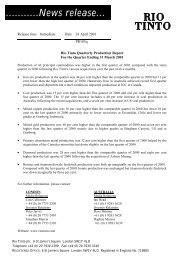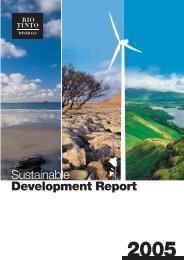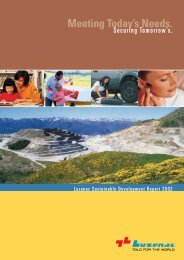Luzenac 20-pages - Rio Tinto
Luzenac 20-pages - Rio Tinto
Luzenac 20-pages - Rio Tinto
You also want an ePaper? Increase the reach of your titles
YUMPU automatically turns print PDFs into web optimized ePapers that Google loves.
such as elk, mule deer, and bighorn sheep. Large grazers such<br />
as these will migrate to lower mountain foothills where the air is<br />
warmer and there is less snow.<br />
Our Yellowstone mine in Montana is right in the heart of this<br />
prime wintering range. In <strong>20</strong>03, our Senior Environmental<br />
Engineer at Yellowstone began working with the U.S. Forest<br />
Service, the Rocky Mountain Elk Foundation and neighbouring<br />
ranchers to determine how our 3,400 acres of mine property could<br />
be enhanced to promote its appeal to wintering elk herds.<br />
With a $10,000 grant from the Elk Foundation, water supplied by<br />
the Forest Service, and cattle willingly provided by neighbouring<br />
ranchers and Forest Service grazing lessees, the Yellowstone mine<br />
property is gradually being transformed into a quadrant of large<br />
fenced grazing pastures that will provide wintering elk with a new<br />
home. The cattle grazing is key to this formula in that the cows<br />
reduce the tall grasses down to short stubble which in turn attracts<br />
the elk who shun ungrazed ranges.<br />
By the winter of <strong>20</strong>04, hundreds of elk will be settling in for the<br />
winter on the environs of the Yellowstone mine.<br />
Looking at new water management ideas<br />
Reducing water consumption is an ongoing target for <strong>Luzenac</strong><br />
operations worldwide.<br />
In <strong>20</strong>03, <strong>Luzenac</strong> Australia continued looking at new water<br />
management ideas for its site in Western Australia, with a view to<br />
reducing its demands on the local fresh water supply.<br />
In <strong>20</strong>03, we continued introducing methods and investing<br />
in equipment that safeguard the environment<br />
¬ A new pump system installed at the sorting station at<br />
our French operation allows us to recycle process water<br />
and has led to a 65% drop in our industrial water<br />
requirements.<br />
¬ The high intensity discharge lighting at our Yellowstone mine in Montana has<br />
been moved so that it shines away from a nearby highway, thereby reducing light<br />
pollution. All outdoor area lighting has been put on timers with photocells to<br />
reduce the total amount of time that the lights are on, thus reducing energy use.<br />
¬ An energy-efficient compressor at our British mill<br />
provides a 50% reduction in compressed air energy use.<br />
The Three Springs site is fortunate enough to have a fresh<br />
water aquifer on the lease. <strong>Luzenac</strong> Australia is currently<br />
assessing the suitability of this water for processing in<br />
terms of chemistry and flow rate. It also intends to enclose<br />
and recycle the water in the processing circuits and<br />
investigate blending the saline water with the fresher water<br />
to slow the corrosion process.<br />
Monitoring effluents<br />
<strong>Luzenac</strong> Australia is also currently carrying out seasonal<br />
studies on the lake system that receives the mining site’s<br />
discharge water.<br />
Initially the lake system was surveyed once a year to meet<br />
regulatory requirements. However, in <strong>20</strong>03, we decided<br />
to investigate whether there were any natural changes<br />
occurring in the lake system potentially caused by<br />
discharge from our mining site. The land is surrounded by<br />
farming properties and is exposed to runoff containing<br />
herbicides and other chemical residues. The lake is also<br />
subject to periods of severe evaporation followed by sudden<br />
high inflows of rainfall.<br />
Studies on the lake have identified several types of micro<br />
flora, invertebrates, fauna and avian species. Information to<br />
date suggests that change in salinity caused by discharge<br />
from our mine may play an important part in the breeding<br />
of these invertebrates. ¬<br />
¬ A new superheater at our Weißkirchen plant in Austria<br />
improves production efficiency and reduces energy<br />
consumption.<br />
¬ Our French operation now uses water from the settling<br />
ponds to wash trucks and shovels, considerably cutting<br />
freshwater consumption.<br />
¬ Three new oil / water separators have been installed at our Sappington mill in<br />
Montana. Two treat stormwater runoff to reduce pollutants prior to discharge, the<br />
other treats compressor condensate by evaporating the water and capturing the oil<br />
for recycling.<br />
¬ Steel-bunded tanks at our British mill have been<br />
replaced with totally enclosed, integrally bunded,<br />
polyethylene tanks. The bunds themselves have a 110%<br />
overspill capacity and are fitted with a spill sensor. The<br />
filling nozzle also has an automatic cut-off to prevent<br />
spillage.<br />
<strong>20</strong>04 targets<br />
talc for the world 13<br />
Elk winter range on reclaimed land<br />
at our Yellowstone mine in<br />
Montana<br />
ISO 14001 Last year, we<br />
reported that all our operations,<br />
except two, had obtained ISO<br />
14001 certification. We are<br />
pleased to report that all our<br />
operations are now ISO 14001<br />
compliant.*<br />
* With the exception of the two joint venture<br />
plants over which <strong>Luzenac</strong> gained management<br />
control last autumn.<br />
environment<br />
> With the support of government<br />
bodies and government-sponsored<br />
consultants, actively investigate further<br />
opportunities for energy consumption<br />
reduction, energy generation from<br />
renewable sources and carbon emission<br />
offsets.



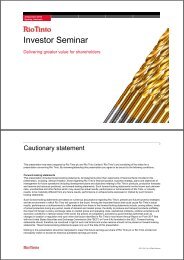


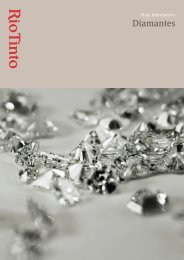

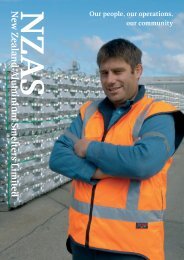
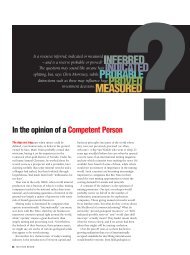
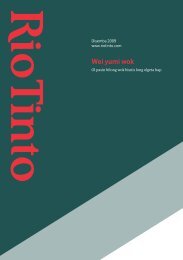
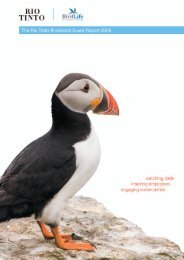
![Download pdf file [PDF: 1.26 MB] - Rio Tinto](https://img.yumpu.com/10319684/1/190x253/download-pdf-file-pdf-126-mb-rio-tinto.jpg?quality=85)

